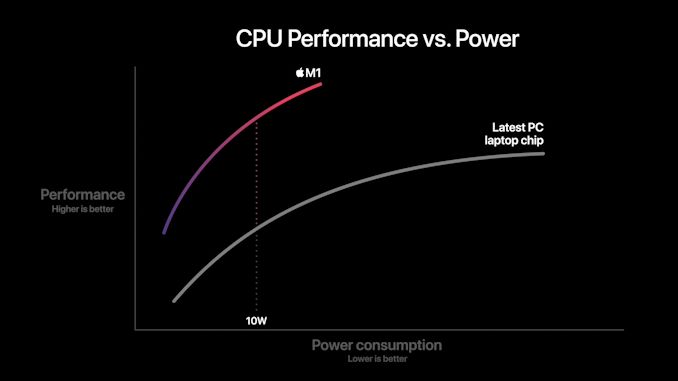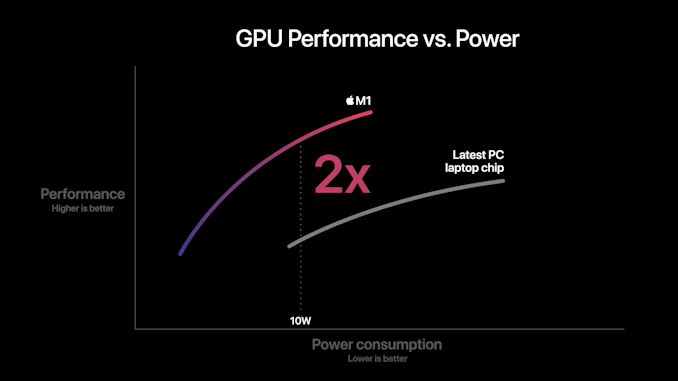Apple Announces The Apple Silicon M1: Ditching x86 - What to Expect, Based on A14
by Andrei Frumusanu on November 10, 2020 3:00 PM EST- Posted in
- Apple
- Apple A14
- Apple Silicon
- Apple M1
Apple Shooting for the Stars: x86 Incumbents Beware
The previous pages were written ahead of Apple officially announcing the new M1 chip. We already saw the A14 performing outstandingly and outperforming the best that Intel has to offer. The new M1 should perform notably above that.
We come back to a few of Apple’s slides during the presentations as to what to expect in terms of performance and efficiency. Particularly the performance/power curves are the most detail that Apple is sharing at this moment in time:
In this graphic, Apple showcases the new M1 chip featuring a CPU power consumption peak of around 18W. The competing PC laptop chip here is peaking at the 35-40W range so certainly these are not single-threaded performance figures, but rather whole-chip multi-threaded performance. We don’t know if this is comparing M1 to an AMD Renoir chip or an Intel ICL or TGL chip, but in both cases the same general verdict applies:
Apple’s usage of a significantly more advanced microarchitecture that offers significant IPC, enabling high performance at low core clocks, allows for significant power efficiency gains versus the incumbent x86 players. The graphic shows that at peak-to-peak, M1 offers around a 40% performance uplift compared to the existing competitive offering, all whilst doing it at 40% of the power consumption.
Apple’s comparison of random performance points is to be criticised, however the 10W measurement point where Apple claims 2.5x the performance does make some sense, as this is the nominal TDP of the chips used in the Intel-based MacBook Air. Again, it’s thanks to the power efficiency characteristics that Apple has been able to achieve in the mobile space that the M1 is promised to showcase such large gains – it certainly matches our A14 data.
Don't forget about the GPU
Today we mostly covered the CPU side of things as that’s where the unprecedented industry shift is happening. However, we shouldn’t forget about the GPU, as the new M1 represents Apple’s first-time introduction of their custom designs into the Mac space.
Apple’s performance and power efficiency claims here are really lacking context as we have no idea what their comparison point is. I won’t try to theorise here as there’s just too many variables at play, and we don’t know enough details.
What we do know is that in the mobile space, Apple is absolutely leading the pack in terms of performance and power efficiency. The last time we tested the A12Z the design was more than able to compete and beat integrated graphics designs. But since then we’ve seen more significant jumps from both AMD and Intel.
Performance Leadership?
Apple claims the M1 to be the fastest CPU in the world. Given our data on the A14, beating all of Intel’s designs, and just falling short of AMD’s newest Zen3 chips – a higher clocked Firestorm above 3GHz, the 50% larger L2 cache, and an unleashed TDP, we can certainly believe Apple and the M1 to be able to achieve that claim.
This moment has been brewing for years now, and the new Apple Silicon is both shocking, but also very much expected. In the coming weeks we’ll be trying to get our hands on the new hardware and verify Apple’s claims.
Intel has stagnated itself out of the market, and has lost a major customer today. AMD has shown lots of progress lately, however it’ll be incredibly hard to catch up to Apple’s power efficiency. If Apple’s performance trajectory continues at this pace, the x86 performance crown might never be regained.












644 Comments
View All Comments
29a - Thursday, November 12, 2020 - link
Folks are people, bit you probably knew that.CharonPDX - Saturday, November 14, 2020 - link
My sister has needed a new laptop for a while - she has a Windows laptop now, but her work laptop is an Apple, and she likes Apple. (She's a government employee, so *CAN'T* use her work laptop for personal uses.)So, ordered a MacBook Air for her for Christmas (splitting the cost with our parents.)
While I was at it, ordered myself a Mini to play with, and probably replace my old 2012 Mini in "home server" use.
Alej - Saturday, November 14, 2020 - link
There’s a running theme on twitter and on a thread on Blender artists forums where they point out that the unique memory and texture compressions available to the M1 chip memory hardware would allow it to fit scenes with 100+GB of textures inside those 16GB for GPU rendering.Apple for a long time has touted that they have clever RAM management at the OS level and I truly believe it, I can use an 8GB 2015 MacBook for light-to-mid work and it’s pleasant while using a Windows Laptop with the same 8GB can prove sluggish even when just doing browser navigation (although many other variables for that to happen besides being actually the memory available).
mdriftmeyer - Saturday, December 5, 2020 - link
Must be some mysterious Fractal Compression [bs] to pull off that fantastical feat of creative story telling.mattbe - Saturday, November 14, 2020 - link
"not when ssd of today is *faster* than memory of even a few years ago."This is simply not correct. Please show me an example where SSD is faster than memory (DDR4) from a few years ago.
alysdexia - Wednesday, November 11, 2020 - link
faster -> swiftlier; Macbook -> MacBook; will -> shalladt6247 - Thursday, November 12, 2020 - link
But regardless of OS, some workloads need more RAM. It's why I jumped ship from Mac laptops a couple generations ago. In situations where I'm running tons of VMs and Docker images, building enterprise Java apps, etc. that 16GB of RAM get chewed through real quick.It's not to say that 16GB isn't good enough for most people -- it certainly is. But in 2020, calling it a "Pro" laptop and unable to handle certain classes of increasingly common professional workloads is not great. That being said, this is a first step. It's clear they're going to have to go to RAM off-package for some machines (at least the Mac Pro), hopefully that will trickle down to the Pro laptops.
Also, I'd LOVE to see Linux distros targeting this hardware. Should be fun to run some benchmarks.
danbob999 - Friday, November 13, 2020 - link
The required RAM has nothing to do with the architecture.ARM requires as much RAM as x86 to run the same applications. No reason why macOS would use half the RAM with Apple silicon. With universal binaries taking more space, RAM usage could even go up a bit.
NetMage - Friday, November 13, 2020 - link
Universal binaries may need more storage but there is no reason they should need more RAM.alysdexia - Wednesday, November 11, 2020 - link
a iPad Pro version?